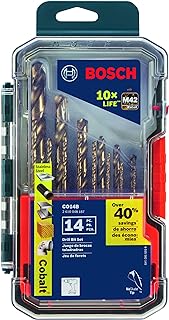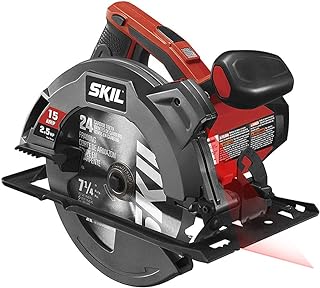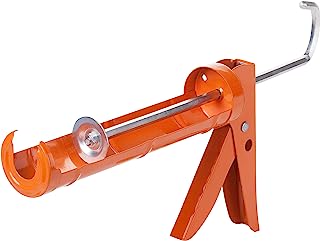5 important factors worth considering when looking for the best circular saw blades
When buying circular saw blades, it’s important to consider precision, durability, and performance. These factors affect the quality of your woodworking projects, as well as how long the blade will last and how well it works. Knowing about different blade types, how the teeth are set up, what materials it works best with, and how many teeth it has is crucial for getting the most out of your circular saw. Picking the right blade isn’t just a choice – it’s a skill that combines knowledge with need, shaping how well your cuts turn out.
See our guide to the best circular saw blades.
Blade size
Choosing the correct circular saw blade is important for your woodworking projects. The size of the blade is a key factor in how well your cuts turn out. Some people think that a bigger blade is always better, but it’s not that simple. While a larger blade might seem good for cutting thick materials quickly, it’s important to think about what you’re actually cutting.
Smaller blades are often overlooked, but they offer better control, especially for detailed work. It’s important to find a balance between blade size and the task at hand to get the best results.
Using a smaller blade can also help make your cuts cleaner and more accurate. By matching the blade size to your project, you can work more safely and efficiently. While a larger blade can cover more area, a smaller one is better for detailed work and reduces the risk of kickback, making your woodworking more precise.
Instead of just focusing on the size of the blade, think about how it matches up with the material you’re cutting and how deep you need to cut. The right blade size depends on your specific cutting goals and woodworking projects, not just one size fits all.
Number of teeth
When choosing a circular saw blade, the number of teeth it has is important for how well it will perform. More teeth usually mean smoother cuts, perfect for precise work on materials like plywood. But if you need to cut quickly through thick wood, a blade with fewer teeth might be better. It’s essential to find the right balance between tooth count and cutting speed based on your project’s needs.
Consider the difficulty of the task and the finish you want to determine the best tooth count for your circular saw blade. Also, think about the material you are cutting. For hard materials like hardwood or metal, fewer teeth can reduce friction and heat. For softer materials like plastic or softwood, more teeth can give you cleaner cuts. Understanding how tooth count and material type work together can help your circular saw blade work better for a wide range of projects.
In the end, finding the right balance between tooth count and material type is key to getting the most out of your circular saw blade in woodworking projects.
Material of the blade
When you’re buying circular saw blades, the material of the blade is very important and can make a big difference in how well your tool works and how long it lasts. High-quality blades are made from different materials, each with its own strengths and weaknesses. For example, carbide-tipped blades are known for lasting a long time and cutting through tough materials like hardwood and metal easily. On the other hand, steel blades are more affordable and versatile but may need to be sharpened more often. Choosing the right blade material depends on the kinds of projects you’re doing and how much you’ll be using the saw.
At first, it might seem like spending more on a better blade material is a waste, but the benefits in the long run are worth it. A high-quality blade will give you cleaner cuts, smoother operation, and make your work safer. Cheaper blades made from lower-quality materials can dull quickly, which could lead to accidents. By focusing on the material of your circular saw blade and picking one that fits your cutting needs, you’re not only improving your tool’s performance but also making your woodworking safer.
Type of cutting application
When you’re buying circular saw blades, it’s crucial to consider the type of cutting you’ll be doing. Different tasks require specific blade designs to get the best results. Whether you’re working on big construction projects or smaller woodworking jobs, choosing the right blade is important for accuracy and effectiveness. By knowing what your cutting needs are, you can pick a blade that will work well for you.
Every cutting task needs a specific blade that can perform well. Different cuts, like rip cuts or crosscuts, require specialized blades that can handle the challenges of each job. By investing in high-quality circular saw blades meant for your specific needs, you can improve the quality of your work and get more consistent results. It’s important not to settle for a blade that won’t work well, as the right one can make a big difference in how well and accurately you can cut things.
Compatibility with the saw machine
When you are buying circular saw blades, it’s crucial to make sure they work well with your saw machine. If the blade is the wrong size, doesn’t fit the arbor hole, or is made of the wrong material, it can lead to problems like poor cutting and safety risks. To avoid these issues, research your saw machine’s specifications carefully and choose blades that match those requirements. Getting the right combination of saw machine and circular saw blades can improve the accuracy and quality of your cuts and make both the blade and machine last longer.
Having the right circular saw blade that fits your machine well can make a big difference in your woodworking. When the blade works seamlessly with your machine, it can boost your efficiency, productivity, and the overall quality of your projects. It’s not just about putting the blade on the machine; it’s about getting the most out of your tools to achieve great results. So, take the time to understand how compatible circular saw blades are with your specific machine to improve performance and excel in woodworking.
Conclusion
Circular saw blades are essential tools for woodworking, providing precision, power, and efficiency. When woodworkers learn about different blade types, tooth configurations, and materials, they can improve their work and achieve clean cuts and smooth finishes easily. Understanding the art and science of circular saw blades doesn’t just make work faster; it also opens up countless creative opportunities in woodworking projects. This knowledge empowers craftsmen to turn their ideas into beautiful finished products with every accurate cut. Want more info on akedo robot, check the best akedo robot.


